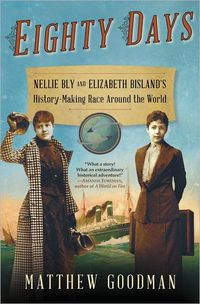

Purchase
Nellie Bly and Elizabeth Bisland's History-Making Race Around the World
Ballantine Books
March 2013
On Sale: February 26, 2013
480 pages
ISBN: 0345527267
EAN: 9780345527264
Kindle: B00985E32O
Hardcover / e-Book
Add to Wish List
Non-Fiction
On November 14, 1889, Nellie Bly, the crusading young female
reporter for Joseph Pulitzer’s World newspaper, left
New York City by steamship on a quest to break the record
for the fastest trip around the world. Also departing from
New York that day—and heading in the opposite direction by
train—was a young journalist from The Cosmopolitan
magazine, Elizabeth Bisland. Each woman was determined to
outdo Jules Verne’s fictional hero Phileas Fogg and circle
the globe in less than eighty days. The dramatic race that
ensued would span twenty-eight thousand miles, captivate the
nation, and change both competitors’ lives forever.
The two women were a study in contrasts. Nellie
Bly was a scrappy, hard-driving, ambitious reporter from
Pennsylvania coal country who sought out the most
sensational news stories, often going undercover to expose
social injustice. Genteel and elegant, Elizabeth Bisland had
been born into an aristocratic Southern family, preferred
novels and poetry to newspapers, and was widely referred to
as the most beautiful woman in metropolitan journalism. Both
women, though, were talented writers who had carved out
successful careers in the hypercompetitive, male-dominated
world of big-city newspapers. Eighty Days brings
these trailblazing women to life as they race against time
and each other, unaided and alone, ever aware that the
slightest delay could mean the difference between victory
and defeat.
A vivid real-life re-creation of
the race and its aftermath, from its frenzied start to the
nail-biting dash at its finish, Eighty Days is
history with the heart of a great adventure novel. Here’s
the journey that takes us behind the walls of Jules Verne’s
Amiens estate, into the back alleys of Hong Kong, onto the
grounds of a Ceylon tea plantation, through storm-tossed
ocean crossings and mountains blocked by snowdrifts twenty
feet deep, and to many more unexpected and exotic locales
from London to Yokohama. Along the way, we are treated to
fascinating glimpses of everyday life in the late nineteenth
century—an era of unprecedented technological advances,
newly remade in the image of the steamship, the railroad,
and the telegraph. For Nellie Bly and Elizabeth Bisland—two
women ahead of their time in every sense of the word—were
not only racing around the world. They were also racing
through the very heart of the Victorian age.
Comments
No comments posted.
Registered users may leave comments.
Log in or register now!
| 


 © 2003-2025 off-the-edge.net
all rights reserved Privacy Policy
© 2003-2025 off-the-edge.net
all rights reserved Privacy Policy